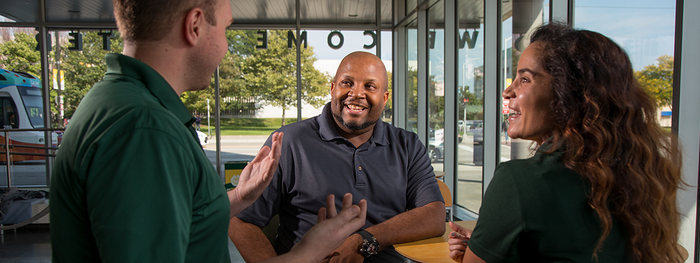Episode 20
Finishing college can be hard when ‘life gets in the way’ – but there is help
March 2, 2020
Thirty-six million adults have some college credit but have yet to earn a degree. The first step colleges and policymakers need to take to re-engage these adults is to listen to those who have traveled through the system.
On the 20th installment of the Lumina Foundation podcast “Today’s Students/Tomorrow’s Talent,” we put names to those numbers—Johnathan Williams and Charletta Thomas—to show a couple of the paths that people have taken to get the education they need.
Johnathan Williams tells me that he went back to Wayne State University to finish his bachelor’s degree after nearly 30 years. What happened to the Detroit native is what happens to a lot of people—life got in the way. He went to college to study accounting, then changed his focus to IT. But his father died, and school began to overwhelm him, so he thought he would take off a semester or two.
He got married, had children, got a job and took a class or two occasionally. But without a degree, Williams found that most opportunities for advancement at work were closed to him and he was passed over for promotions. “I became frustrated that I could do the work, but I didn’t meet the minimum requirements.”
Then he heard about Wayne State’s Warrior Way Back, a program designed to get undergraduate-level students who were previously enrolled at the university but didn’t earn their degree back to school to finish. The program, with a name inspired by the school’s Warrior sports teams, also offered debt forgiveness for students who have an outstanding balance with Wayne State. (The program forgives up to $1,500 over three semesters or upon graduation for qualifying students.)
With the support and encouragement of friends and family, and the option to take most of his classes online, Williams went back to school and was able to finish his final 11 credits in one semester.
“Once I finally graduated and got that degree, I was able to feel a little bit more confident,” he tells me. “Although I knew my skillset, sometimes I couldn’t even get inside the room to show what I can do because I didn’t have the piece of paper.”
Charletta Thomas has a somewhat different story, but a similarly happy result. She was working as a bank officer in Lafayette, Louisiana, when she found out that her employer was cutting its healthcare coverage. As a newly divorced mother of three, she needed that benefit. So, she switched careers from banking to McDonald’s.
Thomas started as a cashier, advanced to shift leader and within a couple of years became a general manager at the restaurant where she worked. Her promotions kept coming, and she eventually became the training coordinator for an owner-operator group that has grown from nine locations to 45. Her advancement was fueled by education and training at Hamburger University, McDonald’s corporate training facility, where she combined on the job training with knowledge and skills to run a McDonalds franchise.
Even with her promotions, Thomas still had not accomplished a goal she set for herself before having children – getting a bachelor’s degree. Determined to reach that milestone, she took advantage of McDonald’s Archways to Opportunity program, taking online courses to earn a bachelor’s degree in business management.
I asked both Williams and Thomas to suggest ways to reach and support people like them who want to go back to school. Their answers are instructive:
-
Make sure that students who have dropped out know there are programs available to help them finish.
-
Schools that don’t have programs like that should get on board. They need to help figure out how to support students not just financially but with options like online classes and childcare.
-
Make the training and education programs compatible with work and family schedules.
The message, Williams says, has to be: “We’re here for you. We want you to be successful.”

